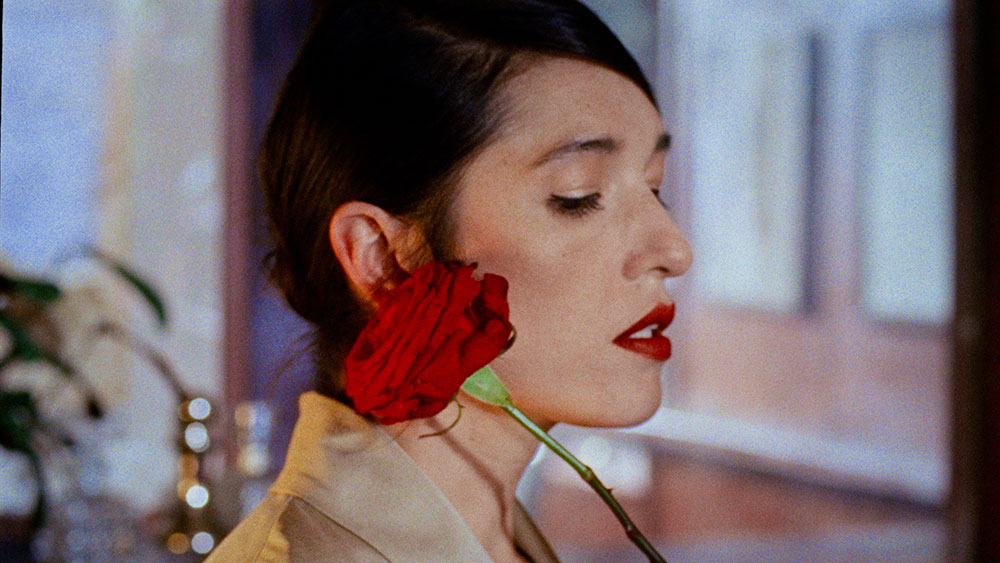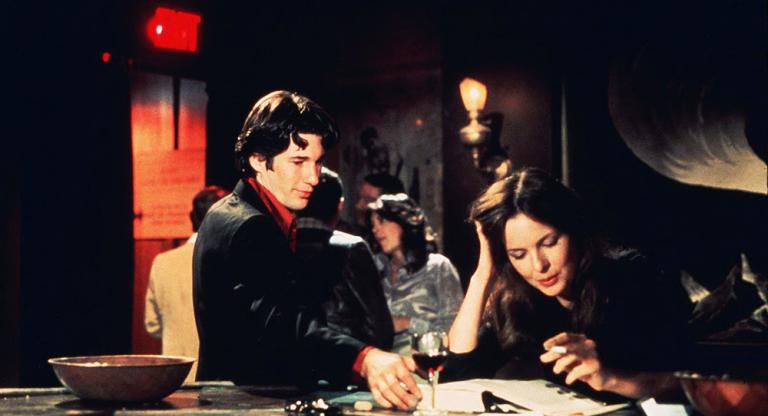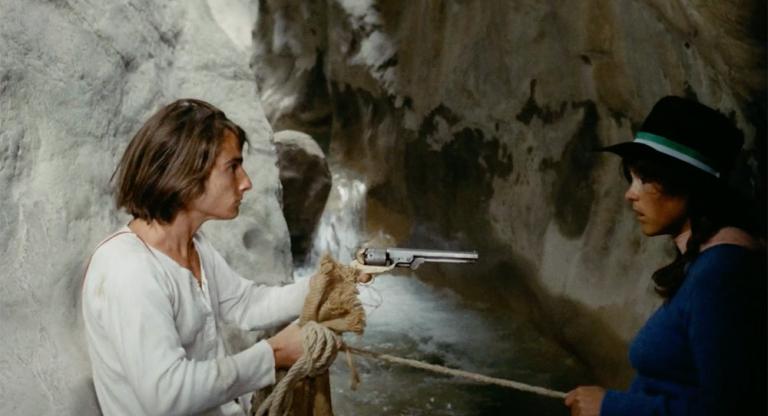The soft rustle of metallic crinkle-paper. The clacking of teeth and tongue against a plated chain. The supple thwomp of a boxing glove hitting the thigh. These are just some of the auditory sensations in Ann Oren’s Piaffe (2023), a veritable ASMR smorgasbord, which is fitting for a film about Foley artists in Berlin. When professional sound manipulator Zara (Simon[e] Jaikiriuma Paetau) has a mental breakdown, her timid sister Eva (Simone Bucio) steps in to complete the job. As Eva immerses herself in this new work, attempting to replicate the sound of horses for a sixty-second pharmaceutical commercial, a tail sprouts from her back. No cause for alarm, the mysterious equine appendage melts away her introversion and awakens her senses, sparking a kinky relationship with a botanist.
What sounds outré is unexpectedly erotic, playful, and radically queer. A film of visual ravishments, Piaffe finds an unforeseen sensuality in things like a leather wingtip edging against velvet or a downy white fern uncoiling under a lens. Flouting boundaries of gender and dissolving distinctions among humans and animals, Oren forges a link between imitation and creation, control and release, with her instinctive editing of seductive 16mm images. I talked to the Berlin-based artist—whose past works include an installation video of Isabelle Huppert’s eye divorced from her body, featuring footage from Michale Haneke’s The Piano Teacher (2001)—about techno, body pleasure, and redirecting gazes in her full-length narrative debut.
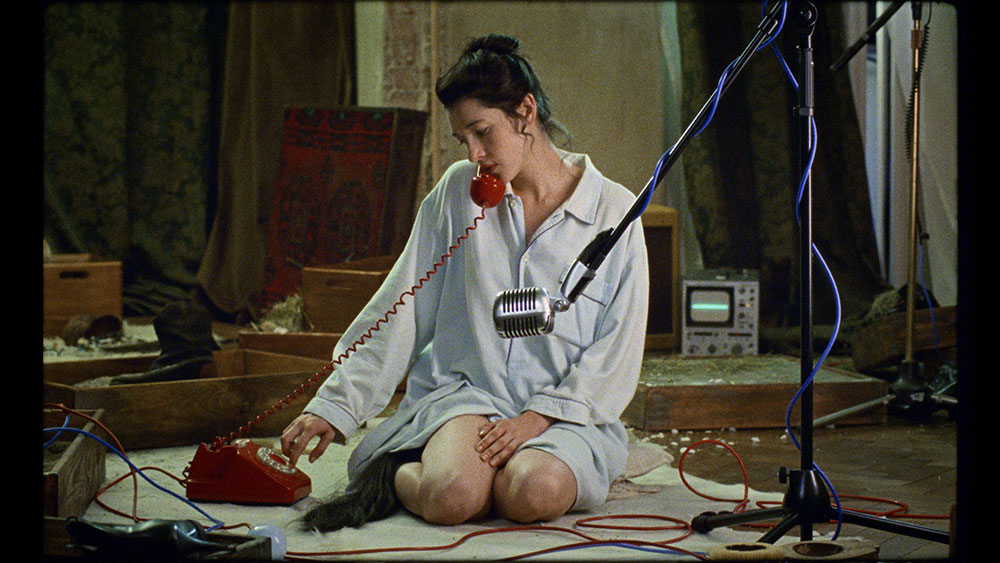
Elissa Suh: This is your first feature film, and I found that it had just the right amount of narrative ambiguity, which isn’t always the case with when artists make narrative films. You studied film in undergrad at the School of Visual Arts—did your studies there inform Piaffe?
Ann Oren: When I studied film, it was all student projects, and then after that you think about what's next. I didn’t think it made sense for me to make narrative films because I felt that the director-viewer relationship has been the same for so long. I needed to establish my own cinematic language in order to make telling a story worth it. Through my art practice, working more in installation, I learned how to tell a story: how to work with the size of the image, imagining the body of the viewer in the space in front of it, experimenting with sound, a little bit [of] animation and found footage, and using editing as a sculpting tool for certain emotion.
After a very long time of doing that, the idea of a film came to me—and at the same time how to dramatize it, by using sound. I actually visited a Foley studio as a film student, and that obviously left a mark because I was really inspired by how animated the artists are when they're working in a dark room, and how dedicated they are to trying to convince the viewers that what they're watching on screen is real. They're kind of like the secret magicians, who are also trying to convey an idea out of nothing, and a lot of people don't know that this profession even exists. I really identify with them when it comes to my more experimental editing and trying to bring meaning across, sometimes from scraps.
ES: For Passage (2020)—your short prequel to Piaffe—you set up old leather cinema benches and bales of hay for the screening as part of an installation. I didn’t have that experience when watching Piaffe, obviously, but it was still a very evocative experience. How did you approach making Piaffe, knowing that it wouldn’t be received in the same sort of context?
AO: Passage did play in film festivals, but from the beginning I intended it as an installation with an element of smell and touch in the space. Piaffe is a longer story and that has a certain kind of advantage: you have a greater chance of the viewer having a relationship with the story, the tail that Eva’s growing. But I had to work harder to get the feeling that I wanted of having the viewer almost touching the screen with your eyes. Sound was an important part of that, and an alternative [to a physical installation setting]. In an installation you can control and set up things that you like, but you can’t with film unless you go to every single cinema. They did have some experiments, like the smellies [Smell-O-Vision], and later John Waters did an experiment with scratch-and-sniff cards, but it's still a bit challenging. Having more sound and more narrative enabled an alternative to that.
ES: Like Passage, the title Piaffe refers to a dressage term, in this case the when the horse trots in place without moving forward. That image brought to mind Eadweard Muybridge’s The Horse in Motion (1878), which shows a galloping horse, but it’s also just within the same frame.
AO: The name originally comes from an Italian word from old days of going into battle on horseback when the rider was on the frontlines, trying to keep the horse in a constant state of excitement, kind of like the football players. And it’s like some of the situations that Eva puts herself in. The connection that I made was with the club scene. When people are dancing, the motions they do with their legs are very similar to that horse movement. I used techno as a heartbeat or a sound element of thrill.
ES: Are you into the techno scene in Berlin?
AO: I love techno. I go clubbing, but not super often because I'm working. But I really like its clubbing culture, and I think it's important to go from time to time, like once a month at least. People that are not part of the scene think it's just pure hedonism. Of course it's fun to dance and let loose, but I really think that the club is like an institution where you go to reconnect with your body, especially now that we're becoming blobs in front of screens. We're constantly bombarded with media. Techno music brings things into this meditative state.
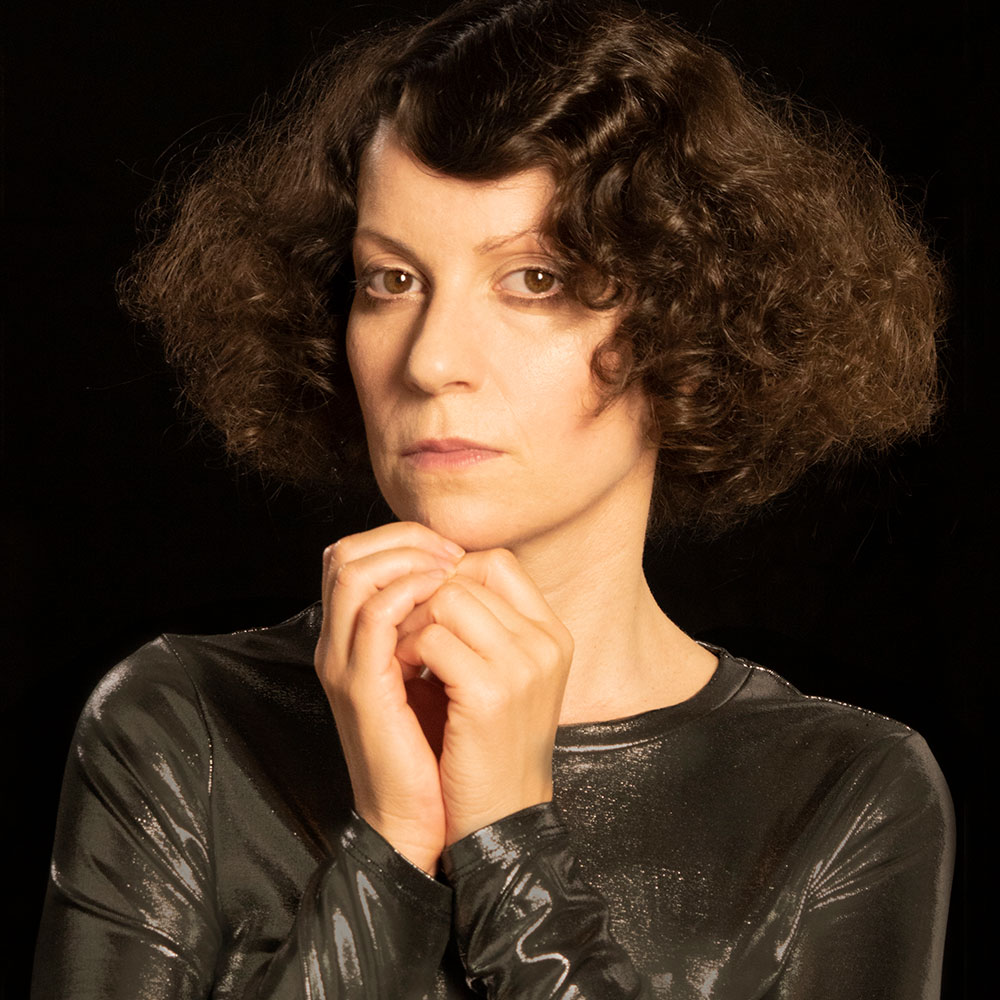
ES: Getting back to Piaffe, there is a storied sociological connection between women and horses, and in cinema and painting. What other significance do they have for you?
AO: I was interested in and a little bit familiar with this world of dressage and artistic riding where the horse and the rider need to be sport partners—it's not one that is dominating the other. The rider is like a tenth of the weight of the horse, but the horse is still an animal that you train and tame to follow all your nuances. You have to communicate. I see it as a kind of a theater of submission. I know some riders, and they have a mentality of play and control, which is a good introduction or parallel to what’s happening later with Eva. You think she's submissive, and then she's dominant. Of course, everything is consensual, it's about it's really about the game aspect of it, the flipping of roles.
If you go to horse stables you see almost only women. On the one hand, they are caretakers—because it's a very expensive hobby to ride horses, and that is the only chance to get to ride—and on the other, they are also leaders of very strong animals, and when you’re riding the horse you’re much stronger than you are on your own. I also read that for a lot of women, as teenagers, horses are kind of like a refuge from the insecurities of the dating scene so it's really a way of being strong outside of this recognition[-seeking] and finding somebody to accept you as a potential dating partner. And of course, centaurs were usually they were male, so it was interesting to work with a female actress as she explores a very fluid sexuality and gender identity, bringing her together with animals that she identifies with through the screen. I wanted to see how much I could push the limits into animality and how much the audience could take.
ES: That fluidity seems also to be depicted through the lighting. Eva seems to favor a blue wardrobe, but then also starts gravitating towards red, and later both colors appear more and more.
AO: Club lights are usually red and blue, so it started with that. Then I decided, through the lighting and also the production design and the costumes, to associate blue with Eva and then red with Zara, which is established in the beginning but then mixed later on because the characters are mixed. You probably noticed that there are red flares when Zara isn’t even present in the scene, to show how they're intermingled because her character is intended to be a part of Eva’s. The colors are used to show this merged consciousness, or two parts of one character.
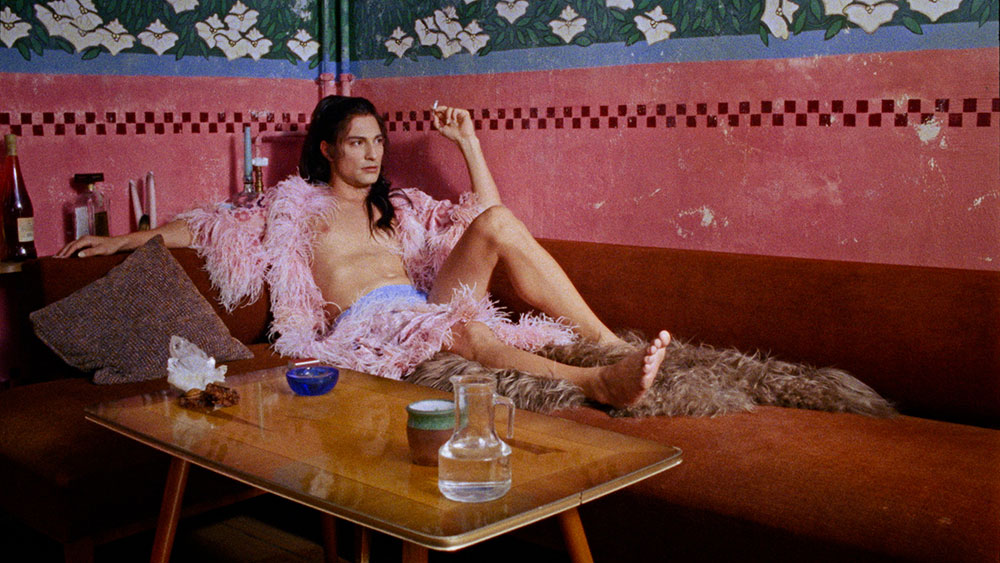
ES: When people grow extra organs or appendages in cinema, it’s usually cause for concern. But it’s never frightening for Eva. Can you talk a little bit about the morphing of her body in the context of creating this pleasure and sensuality—instead of, say, as body horror?
AO: That's a great question. Someone mentioned it as body pleasure. The scene when she's at the doctor's office is when it's clear that she accepts and is thrilled by this new organ. The film is a celebration of otherness, and people that have a body that is different—what exactly is different is really up to you. It’s about the feeling of embracing it and loving it. At the London Film Festival, there was a woman who was disabled and had the walking aid, and she told me after the screening that she really identified with this character and her experience of accepting her own body, which was really one of the most exciting encounters that I had with a viewer. Some people have told me they have teenage kids they think would really identify with this and the changing body of the character.
If I'm not mistaken, in American films when you say “coming-of-age film,” it almost always refers to a teenager. I'm really interested in this term, and I think this is something that goes way beyond the teenage years. We're constantly in this state of becoming—of [changing] identity, and bodies—and I think that's what she is experiencing. It’s not just late puberty. These moments are one of the most exciting things about being alive, when we discover something different about ourselves through the way that we're perceived by others, letting it happen and being empowered, and ready for what will come next.
ES: Earlier you described your way of editing as sculpting images. Can you talk about constructing the gazes in the film, which go from plants to animals and humans and are embedded with eroticism?
AO: I think a lot of it is really intuitive, so it's a little bit difficult to explain. Some details of closer shots and close-ups were conceived at the script level. It was very important to bring the viewer into the intimacy of the character's body. Some people I talked to didn't really understand the connections I was making, but then it came together in the editing. I was able to demonstrate it but I couldn't verbalize it. We have different species—human, animal, and plant—in the film, and I wanted to bring them closer to each other than we normally see them, because Eva is becoming an interspecies herself. I wanted to have a similar intimate gaze on the horse and on the fern, and to see their movement, especially the fern with the time lapse—the way that it uncoils and reacts to the lights. It desires something. It needs something.
The three main characters are communicating in the film not through dialogue but through something that they're sensing from each other with their bodies. This is how we connect with those [whom] we really connect with in our lives. When you discover a new person like this, it's very, very thrilling, and I wanted to bring those feelings across in the film.
ES: In the film, it’s Eva’s dedication to her work that leads to her transformation. Do you identify with that process as well—becoming so absorbed in a project that you become it?
AO: Yes, absolutely. It's about falling into your own work and being so focused on it that everything that you come across becomes a part of it or becomes a potential inspiration and soaked in it. Suddenly everything connects when you’re really in a project, even when nobody but you can understand.
Piaffe is now playing at the Quad.
